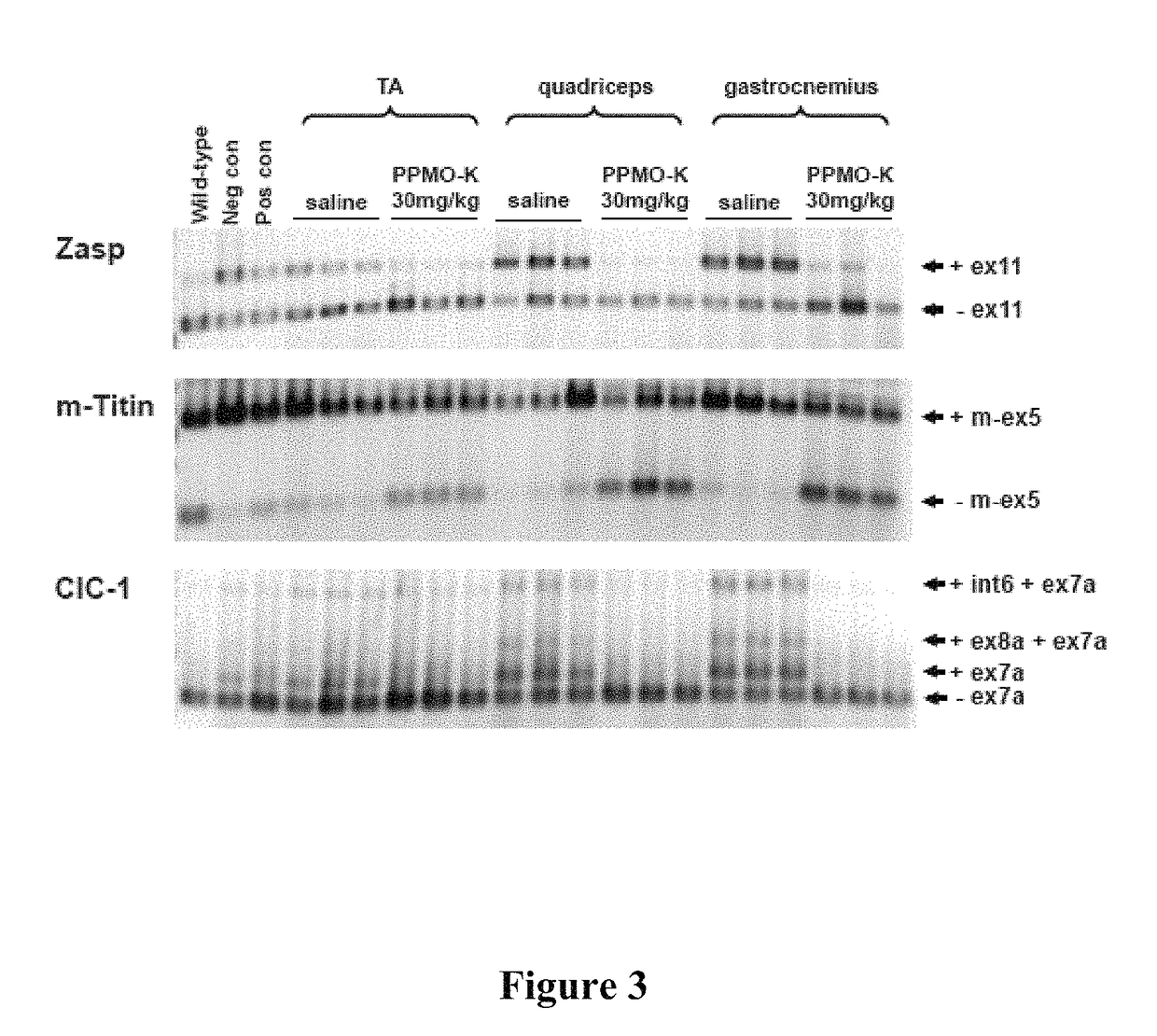Peptide-linked morpholino antisense oligonucleotides for treatment of myotonic dystrophy
a technology of myotonic dystrophy and peptide-linked morpholino, which is applied in the field of peptide-linked morpholino antisense oligonucleotides for treatment of myotonic dystrophy, can solve the problems of no therapeutic agents in the clinic, and achieve the effect of reducing the frequency reducing the number and intensity of cug rna foci
- Summary
- Abstract
- Description
- Claims
- Application Information
AI Technical Summary
Benefits of technology
Problems solved by technology
Method used
Image
Examples
example 1
Intramuscular Injection of Two Different PPMO Conjugates into Tibialis Anterior Corrects aberrant RNA Splicing
[0108]Large expansions of CUG trinucleotide sequences provide the basis for a toxic RNA gain-of-function that leads to detrimental changes in RNA metabolism. Such a CUG repeat element normally resides in the 3′ untranslated region of the protein kinase DMPK, but when expanded it is the genetic lesion of myotonic dystrophy type I (DM1), a hereditary neuromuscular disease. The pathogenic DMPK transcript containing the CUG expansion is retained in ribonuclear foci as part of a complex with RNA binding proteins such as muscleblind-like 1 (MBNL1), resulting in aberrant splicing of numerous RNA transcripts and physiological abnormalities including myotonia.
[0109]In this example, condensation synthesis reactions were conducted to generate PPMO conjugates containing a 25 mer CAG sequence-based morpholino (Wheeler et al., 2009, Science 325:336-339), CAG25, and a cell-penetrating pept...
example 2
Repeated IV Injections of PPMO-B and PPMO-K Effectively Ameliorate Spliceopathy in vivo
[0121]Having confirmed that modification of CAG25 with peptide B or K did not abrogate its bioactivity, this example evaluates whether PPMO-B and PPMO-K could modulate the effects of toxic RNA in HSALR mice using an IV dosing regimen.
Materials and Methods
[0122]Systemic Delivery Studies in HSALR
[0123]CAG25, PPMO-B, and PPMO-K were dissolved in saline and administered to male and female HSALR homozygous mice at a dose of 30 mg / kg bodyweight by tail vein IV injection once a week for six weeks. Blood was collected by retro-orbital bleed 24 h following the last dose. Approximately one week following the final dose, mice were evaluated for the presence of myotonia as described in Electromyography procedures. Mice were then killed; muscle sections were frozen in liquid N2 for RNA analyses or embedded in OCT medium and frozen in cooled isopentane for immunofluorescence and FISH analyses.
[0124]RT-PCR Anal...
example 3
PPMO-K Disrupts CUG Nuclear Inclusion Complexes in Skeletal Muscle and Results in a Redistribution of MBNL1 Protein
[0130]In order to determine the fate of ribonuclear foci in mice treated with PPMO-K, this example demonstrates fluorescence in situ hybridization (FISH) to detect CUG ribonuclear inclusions in muscle.
Materials and Methods
[0131]Frozen sections of quadriceps muscle 6 μm thick were processed to detect localization of MBNL1 protein via immunofluorescence as described (Lin et al., 2006, Hum Mol Genet 15:2087-2097) with the following modifications: the polyclonal antibody A2764 was used at a concentration of 1:5000 followed by incubation with Alex-568-labeled goat-anti-rabbit polyclonal secondary antibody at a concentration of 1:500. Samples were imaged using a LSM510 META laser scanning confocal microscope configured for imaging DAPI and Alexa Fluor-568 sequentially. Examination was conducted using a 100x / NA1.45 Plan-Fluar oil immersion objective with 4x zoom.
Results
[0132]I...
PUM
| Property | Measurement | Unit |
|---|---|---|
| pH | aaaaa | aaaaa |
| pH | aaaaa | aaaaa |
| mass | aaaaa | aaaaa |
Abstract
Description
Claims
Application Information
 Login to View More
Login to View More - R&D
- Intellectual Property
- Life Sciences
- Materials
- Tech Scout
- Unparalleled Data Quality
- Higher Quality Content
- 60% Fewer Hallucinations
Browse by: Latest US Patents, China's latest patents, Technical Efficacy Thesaurus, Application Domain, Technology Topic, Popular Technical Reports.
© 2025 PatSnap. All rights reserved.Legal|Privacy policy|Modern Slavery Act Transparency Statement|Sitemap|About US| Contact US: help@patsnap.com



